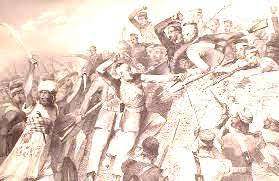The Reang Uprising in Tripura (1942-43)
Tripura History | June 22, 2024 10:51 PM | 1019 views
Unraveling the Pages of History: The Reang Uprising in Tripura (1942-43)
In the annals of Tripura's rich history, there lies a chapter that resonates with the echoes of rebellion and resistance – the Reang Uprising of 1942-43. This poignant historical event, shrouded in the shadows of oppression and exploitation, sheds light on the tumultuous socio-political landscape of pre-independence India. Join us as we journey back in time to unravel the complexities of this pivotal moment in Tripura's past.
Context: At the helm of Tripura's governance stood Raja Bir Bikram Manikya, presiding over a princely state intricately woven into the fabric of the British protectorate. His administration, modeled along British lines, operated within a framework of colonial influence, setting the stage for simmering discontent among the indigenous Reang tribesmen.
Causes: The Reang tribesmen found themselves ensnared in a web of exploitation and oppression, particularly exacerbated during the turmoil of World War II. The rapacious actions of middlemen, coupled with economic hardships, fueled the flames of discontent within the Reang community, igniting a spark of resistance against the status quo.
Leadership: At the forefront of this uprising stood Ratan Muni Reang, a figure revered for his unwavering commitment to the cause of independence and justice. Under his leadership, the Reang rebels rallied against the forces of oppression, seeking to reclaim their dignity and autonomy in the face of adversity.
British Manipulation: In a bid to quell the uprising, the British authorities manipulated the narrative, portraying the Reang rebellion as inherently anti-monarchical. Ratan Muni's fervent advocacy for independence drew parallels with the Chittagong armor raid, painting him as a threat to the established order and garnering support for the suppression of the uprising.
Crackdown: The British-backed army launched a relentless crackdown on the Reang rebels, unleashing a wave of violence and repression that reverberated across the region. Villages were pillaged, lives were lost, and scores of rebels were imprisoned, marking a dark chapter in Tripura's history of resistance.
Impact: Despite the brutal suppression of the uprising, its reverberations echoed far beyond the confines of Tripura. The Reang Uprising laid bare the insidious effects of British interference and the appeasement of certain classes at the expense of indigenous livelihoods, serving as a stark reminder of the perils of colonial rule.
Jawaharlal Nehru's Response: In the aftermath of the uprising, Jawaharlal Nehru, a stalwart of India's independence movement, advocated for a committee to address the grievances of the Reang people and ensure their well-being. His intervention underscored the significance of the uprising in the broader struggle for independence and social justice.
As we reflect on the tumultuous events of the Reang Uprising, we are reminded of the enduring spirit of resistance that courses through the veins of Tripura's history. In the face of adversity, the Reang rebels stood firm in their quest for freedom and justice, leaving an indelible mark on the tapestry of India's struggle for independence.
